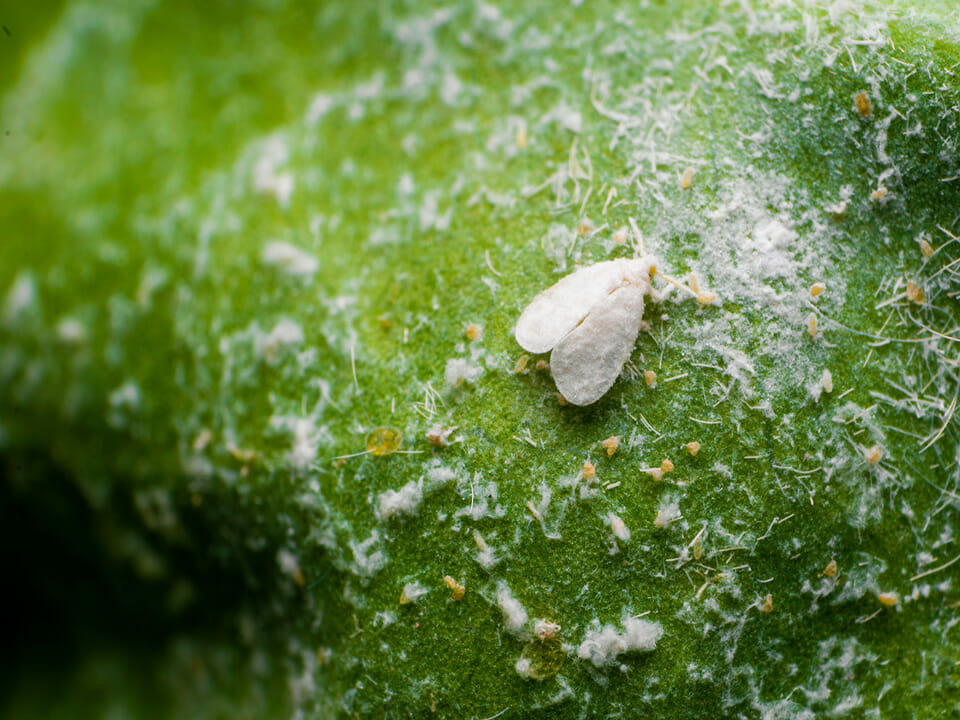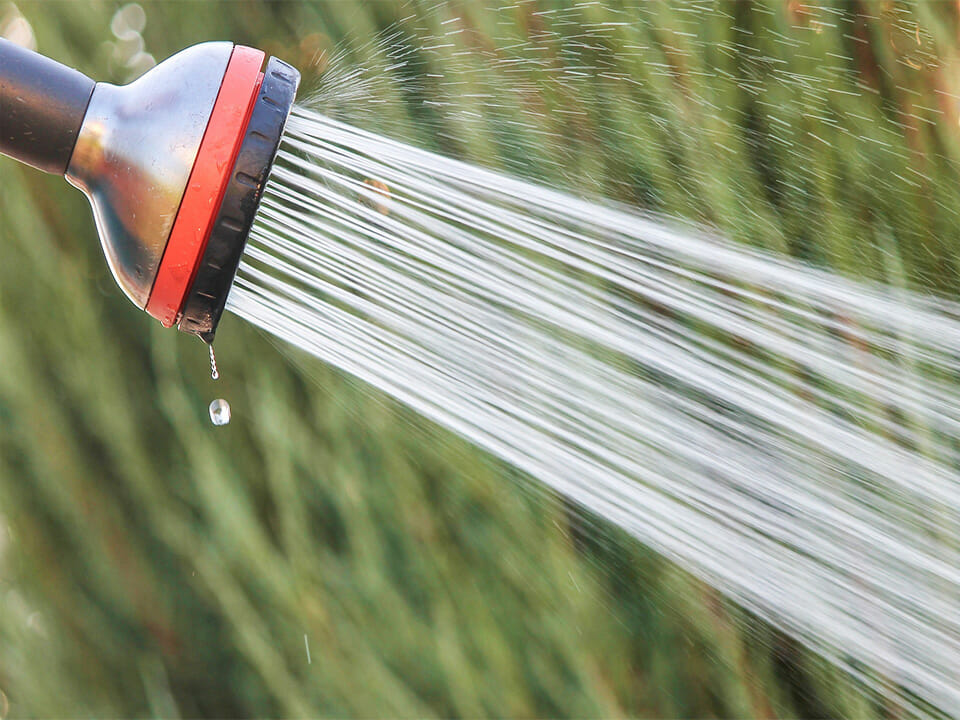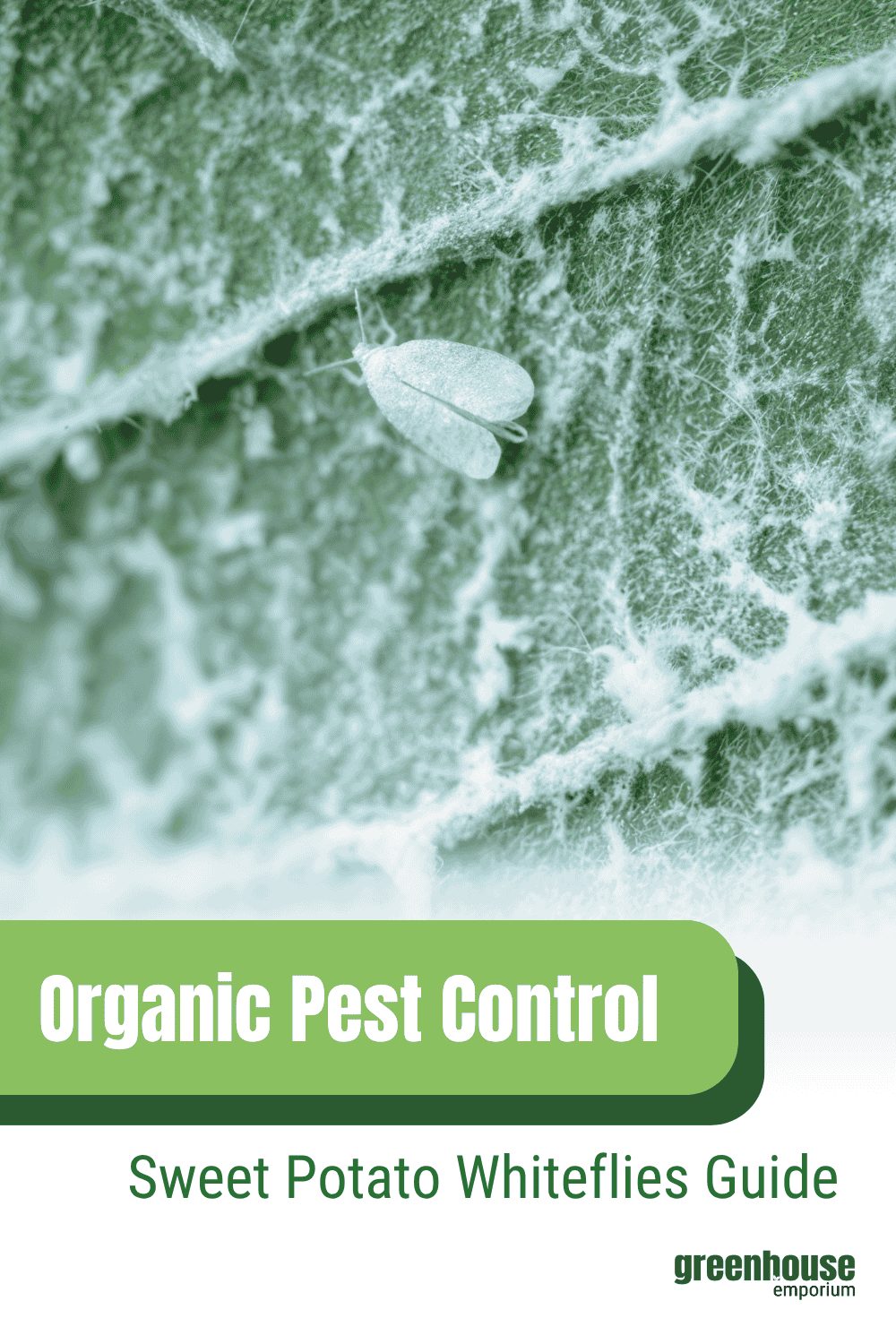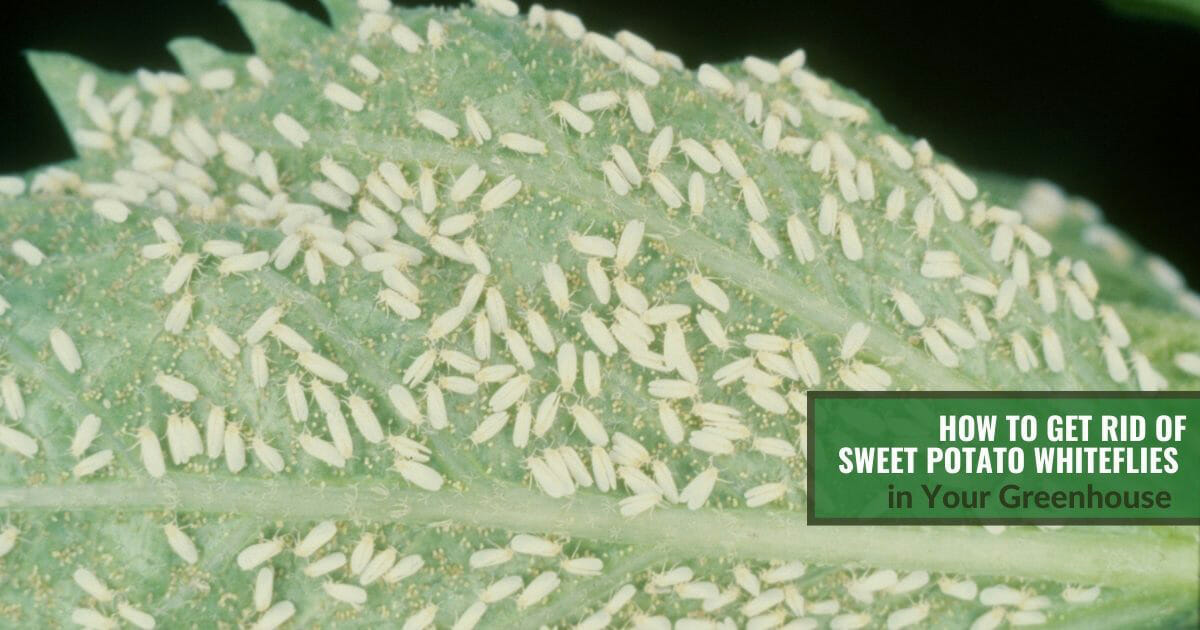


Sweet potato whiteflies (also known as silverleaf whiteflies) are tiny white flying pests that can inflict a significant amount of damage in your greenhouse. They tend to be most active in the summer in tropical to subtropical climates. However, warm greenhouses offer an ideal climate that can allow them to thrive outside of these parameters.
Fortunately for you, the greenhouse grower, you can eliminate sweet potato whiteflies from your greenhouse with a combination of simple, effective, and organic methods. For example, you can introduce natural predators, apply insecticidal soap, or place sticky traps all around your greenhouse to keep the population of sweet potato whiteflies down.
Although these little white pests appear relatively harmless, they can spread rapidly in the greenhouse environment. Before you know it, one or two whiteflies can turn into an entire infestation, resulting in a host of damaged plants. So let’s learn a little more about sweet potato whiteflies and how you can control their population below!
What are sweet potato whiteflies and why are they in my greenhouse?
Bemisia tabaci, or sweet potato whiteflies, belong to the Animalia Insecta family of Aleyzodidae and thrive in tropical and subtropical climates. Greenhouses make an ideal environment for these pests because they offer two key elements: warmth and moisture.
You might be wondering: how did the sweet potato whiteflies get inside my greenhouse in the first place?
There are several possibilities, but one of the most common mistakes a greenhouse gardener can make is bringing outside seedlings (such as from a nursery). Unbeknownst to you, some of these seedlings could already be infested by these whiteflies (or their eggs) and once you introduce them to your greenhouse they can spread and cause an infestation.
Why are sweet potato whiteflies bad in a greenhouse?
Although there are about 1,500 recognized species of whiteflies in the world, sweet potato whiteflies are one of the most notorious for greenhouse gardeners. Sweet potato whiteflies are a type of sap feeder, which means they compromise the health of your plants by feeding on them. This can result in yellowing leaves or premature leaf droppings.
Sweet potato whiteflies can also transmit different plant viruses that can seriously damage or even kill your plants. Even a relatively small population of whiteflies has the possibility of inflicting great damage, so it’s important to know how to spot an infestation and how to deal with it as soon as possible.
How to spot sweet potato whiteflies
Faded, drying leaves are a clue that whiteflies have been sucking juices from the underside of plant leaves. If they have been feasting for many days, the leaves may show a sticky matter or the whitefly honeydew. Ants can be there as well as the honeydew end user.
If you find the leaves of your plant fading, yellowing, drying up, or falling off prematurely, it could be a sign that sweet potato whiteflies have been feeding on your plant. Look out for the adult whiteflies, but also check the undersides of leaves for their clusters of oval eggs or nymphs. If you find sweet potato whiteflies in your greenhouse, it’s important to try and control their population as much as possible using the following methods.

8 ways to prevent and get rid of sweet potato whiteflies in a greenhouse
You’ll have to be diligent to notice sweet potato whiteflies in the early stages of infestation. Make it a priority to regularly check the underside of your leaves for their eggs and/or nymphs. Once you’re certain that you have sweet potato whiteflies in your greenhouse, the next step is to take action so they don’t turn into a serious infestation.
There are various pest control solutions for sweet potato whiteflies, but the best way to deal with them is the use of organic pest control methods. Although pesticides might’ve been effective in the past, whiteflies have developed a high level of resistance. As a result, it’s much better to use a combination of organic pest control methods to control and get rid of sweet potato whiteflies in your greenhouse.
Blast them with water
If your infestation is relatively minimal, one of the simplest yet most effective methods you can implement to control the sweet potato whiteflies is to simply blast them with water. The best way to achieve this is using a hose on a setting strong enough to damage the adult whiteflies and dislodge their nymphs/eggs but light enough to not harm your plants.
You can use this method at any time or as often as you like, just take care not to damage the leaves of your plants or overwater them by constantly spraying jets of water around the greenhouse. Note: This method is not ideal for seedlings.

Kill whiteflies with insecticidal soap
In addition to blasting sweet potato whiteflies with water, you can consider spraying your plants with insecticidal soap to kill the sweet potato whiteflies that linger after a blast of water.
Carefully follow the instructions on the packaging of the insecticidal soap you intend to use. Make sure to apply the insecticidal soap mixture to all the parts of your plants, especially the undersides of the leaves.
This method works best in cooler temperatures, so the ideal time to apply insecticidal soap in your greenhouse is in the mornings or evenings.
Using insecticidal soap in intense heat may result in adverse reactions. Make sure to reapply the treatment 2-3 times to get rid of sweet potato whiteflies completely.
Use sticky traps
Sticky traps are very effective in monitoring and getting rid of sweet potato whiteflies in your greenhouse. You can easily make your own sticky trap with bright yellow construction paper, petroleum jelly, and dish soap. Spread a mixture of petroleum jelly and soap onto the paper to create a trap sticky enough to keep the pests glued once they land on it.
Place the prepared sticky traps in affected areas of your greenhouse. Sweet potato whiteflies are attracted to the bright color thinking it’s fresh foliage, so they’ll move to the cards and get stuck there.
Alternatively, you can buy premade sticky traps for sweet potato whiteflies control. Either way, keep in mind that you’ll need to replace the sticky traps when they fill up or lose their stickiness. Even after the whitefly infestation has gone down, it’s a good idea to leave a couple of traps around your greenhouse to monitor pest populations.
Attract natural predators to your greenhouse
Introducing natural predators of sweet potato whiteflies can help you control your infestation significantly with minimal effort. Beneficial insects such as dragonflies, spiders, ladybugs, and wasps all consume whiteflies.

To get rid of sweet potato whiteflies with these natural predators, you’ll need to make your greenhouse attractive to these insects and give them a way in (such as an open window or door).
Natural predators like wasps can even be purchased from vendors. Just one wasp can take down over 100 sweet potato whiteflies, so you can buy these insects, release them in your greenhouse and watch them take down your enemies. The best natural predator of sweet potato whiteflies is Encarsia Formosa, an endoparasitic wasp. You can also buy these from vendors of pest control agents.
If you intend to go this route, make sure to avoid the use of pesticides so that you don’t accidentally kill off your beneficial insects.
Inspect your plants before bringing them into your greenhouse
Sweet potato whiteflies can start infesting your greenhouse when you bring affected seedlings into your greenhouse. An important step you should always take when dealing with sweet potato whiteflies is to thoroughly inspect new plants before adding them to your greenhouse.
If you notice that a plant has been infested by sweet potato whiteflies, make sure to bag and garbage it appropriately. Even if you don’t immediately spot any whiteflies on new plants, it’s a good idea to keep new ones apart from the rest for some time. This will make it much easier for you to inspect the plants and identify any pest problems as they come up.

Get rid of sweet potato whiteflies with a vacuum
If you have tried many other methods and your greenhouse infestation is severe, vacuuming can be a great method to deal with these pests. You can use a vacuum (such as a shopvac) to get rid of both the adult whiteflies and the nymphs. Simply go around your greenhouse with the vacuum, shake your plants to agitate the whiteflies, and suck away!
Once you’re done vacuuming, dispose of the contents properly. You can also take the vacuum and freeze it for 24 hours to kill the whiteflies.
Deter whiteflies with reflective mulch
Another effective method of dealing with sweet potato whiteflies is using reflective mulch. You can use aluminum reflective mulch to deter whiteflies from your greenhouse plants. Reflective mulch makes it difficult for whiteflies to find their preferred plants.
Keep your greenhouse clean to prevent an infestation
One of the reasons why you may be dealing with sweet potato whiteflies infestation may be as a result of an unkept greenhouse. Sweet potato whiteflies love damp, warm, and dirty environments. They can easily reproduce and take over your greenhouse if they have such an enabling environment.
Make sure to clean your greenhouse thoroughly in order to prevent these pests from breeding and damaging your plants. Take time to remove all infected plants in your greenhouse and dispose of them appropriately.
Sweet potato whiteflies are tiny pests, but they can cause a lot of trouble to greenhouse gardeners. These pests are very common, so there’s a high chance you’ll have to deal with them eventually even if you haven’t already. But there’s no reason you can’t keep their population in control if you’re armed with the knowledge of how to deal with them effectively.
























